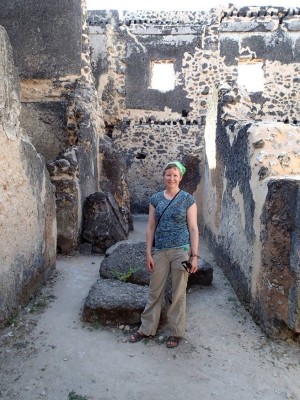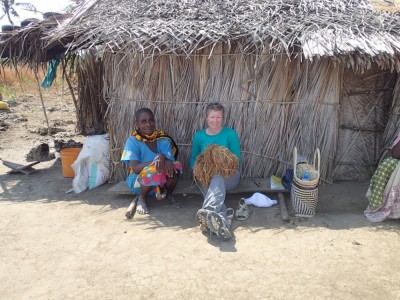Dr. Sarah Walshaw is a historical archaeologist, specialising in archaeobotany. This interview explores how she came to be the macrobotanical specialist on the Songo Mnara Archaeological Project and investigating the Atlantic trade along the Gambia River. Dr. Sarah Walshaw is currently a limited term instructor, within the Department of History at Simon Fraser University.
What area of archaeology do you work in?
Historical archaeology.
What kind of specialism do you have?
Archaeobotany, the study of ancient plant remains, particularly as they inform human-plant relationships. Also, the ethnoarchaeology of crop processing.
How did you get involved in this aspect of archaeology?
I began my undergraduate career in biochemistry, and when I was introduced to anthropology I switched to a double major. I was most interested in reconstructing human diets, and studied zooarchaeology, human osteology, and stable isotopes. At that time, the department was hosting a phytolith specialist (Arlene Miller Rosen) so I had the opportunity to learn this technique, which inspired my current interest in plant remains.
What qualifications do you have and where did you study?
I have a BSc in Archaeology from the University of Calgary (with a minor in Primatology!) in Canada, an MA in Anthropology from the University of Alberta, Canada and a PhD in Anthropology from Washington University in St. Louis (USA). I also pursed post-doctoral research in the Department of Archaeology at my current institution, Simon Fraser University (Canada).
What started your interest in archaeo- and ethno-botany?
I pursued a phytolith study for my MA research, looking at phytoliths from human dental calculus from ancient Syria. I became somewhat dissatisfied with the limitations of this approach, and turned to macrobotanical analysis to add more methods to my repertoire.
How do you use ethnobotany as a part of your archaeological interpretation? What can it tell us about past societies?
Ethnobotany, the study of current or recent historic human-plant relationships, can help us understand earlier societies in a few ways. First, collaborations with local peoples can provide information about plant uses, ecologies, and local taxonomies that can help us identify and interpret ancient plant remains. Second, ethnoarchaeological research – particularly concerning agriculture – can connect material patterns to human behaviours; this can provide models for interpreting botanicals in the archaeological record. Third, collecting modern plant specimens helps build a comparative collection with which to aid archaeobotanical identification.
What process do you follow to get the botanical remains from your samples?
I use flotation – a method of water separation – to isolate charred plant remains from the soil. Most of the time I use bucket flotation, because my fieldwork sites are too distant from water and electricity supplies to use a flotation machine, and because the bucket system uses locally-available materials, for the most part. After the light fraction has been dried, it is bagged and labelled for transport to the Archaebotany laboratory, where I analyze the remains under a light microscope back in Canada.
How long does it take you to get the results from the archaeobotanical remains?
Analysis is very time-consuming; typically several hours of sorting, identification, labelling, and photography is required per sample. After the results have been entered into a spreadsheet, it takes additional time to convert the data into meaningful units of analysis, such as ratios (e.g. number of seeds per gram of wood charcoal). So for a field season several weeks in length, it can take over a year to analyse samples part-time and write up the results.
Some of your other areas of interest are African Archaeology, specifically the Swahili Coast. What piqued your interest in this area?
I have been very fortunate in gaining fieldwork opportunities in the “Old World.” My MA supervisor, Dr. Nancy Lovell, took me to Egypt as a research assistant, looking at ancient diet and health at the site of Mendes. For my PhD research, Dr. Adria LaViolette and Dr. Jeff Fleisher invited me to join their project on Pemba Island as an archaeobotanical specialist. It was fantastic to work alongside these experienced and generous scholars, and I am grateful to them for introducing me to Swahili archaeology. I was able to learn some of the Swahili language through coursework at Washington University in St. Louis, and by practicing with Swahili speakers during fieldwork. My dissertation research opened up further questions about coastal agriculture that I pursued during post-doctoral research concerning the ethnoarchaeology of crop processing.
How do you find working on archaeological excavations? Is it difficult to handle your samples in the field?
I find fieldwork very rewarding. I enjoy travel and experiencing different cultures and countries. I also really enjoy excavation, however a large amount of my time is taken up with flotation and ethnobotany. Flotation samples are not problematic unless they are very large in size. Care must be taken to dry flotation samples slowly so that the remains stay in good condition. Samples should be shipped in hard-sided containers so they aren’t crushed. I think sediment is far more difficult (and heavy!) to work with than light fractions.
What projects are you currently involved with?
I have two active projects. I am the macrobotanical specialist on the Songo Mnara Archaeological Project, led by Dr. Stephanie Wynne-Jones (University of York, UK) and Dr. Jeff Fleisher (Rice University, USA). Researchers at this UNESCO World Heritage Site are examining how people at this 14th-15th century settlement used open spaces and the built environment (principally houses), where ritual and commemoration seem to have been very important. This project is of huge interest to me because it represents a unique opportunity to investigate an under-studied time period in Swahili chronology, and on a large project like this, I can integrate my data with other botanical (phytolith) and environmental data being collected.
The second project I work on investigates the era of Atlantic trade along the Gambia River (in The Gambia) in collaboration with Dr. Liza Gijanto (St. Mary’s College of Maryland, USA). These sites are very interesting in that the material remains of European-African interactions can serve to challenge, complement, or reinforce information drawn from the documentary record.
Lastly, I have an opportunity to build greater archaeobotanical resources in Tanzania through collaboration with Dr. Thomas Biginagwa of the University of Dar es Salaam. In February 2014, I will conduct a workshop on archaeobotanical analysis for Dr. Biginagwa and his students, and bring over the resources necessary to establish a functional archaeobotanical lab at UDSM. I am thrilled to be a part of this process, and see researchers in Tanzania build their own capacities for archaeobotanical research.
Any tips for the undergraduates reading this interview wanting to work in the same kind of role?
Archaeobotany is a very rewarding speciality in archaeology, and demands a lot of time in the lab, which may be appealing to some. In addition, archaeobotany is a skill that can be applied to jobs in archaeology outside of academia, including contract work. I do suggest that budding archaeobotanists gain some experience in plant taxonomy or biology, to gain familiarity with plant nomenclature and anatomy. One of the advantages of such a speciality is that researchers can work on projects in different areas: for example, during my training I worked on material from a feasting context at Cahokia Mounds (USA) collected by my advisor Dr. Gayle Fritz; I examined Neanderthal teeth from Dr. Erik Trinkaus’s collection for evidence of phytoliths; I travelled to Turkey to study with Dr. Fusun Ertug and examine Gordon Hillman’s collections at the British Institute in Ankara. However, there are potential drawbacks to such collaborations, in that researchers may have little control over sampling, and may not be involved in the fieldwork component. Even within this subfield, researchers can specialize further; many archaeobotanists are involved in questions of plant domestication and the origins of agriculture, some specialize in different methods like starch grain analysis and phytolith analysis, and some work in specific time periods and geographic areas. I myself find historical archaeobotany and ethnobotany in sub-Saharan Africa very rewarding. In terms of African archaeology, many aspects of human-plant relationships have yet to be adequately studied.
For further information on Sarah, visit
http://www.sfu.ca/history/faculty-and-staff/ltsessional/sarah-walshaw.html
To view some of Sarah’s recent work, follow:
http://www.tandfonline.com/doi/abs/10.1080/00438240903430399#.UufxEOlFBlY





